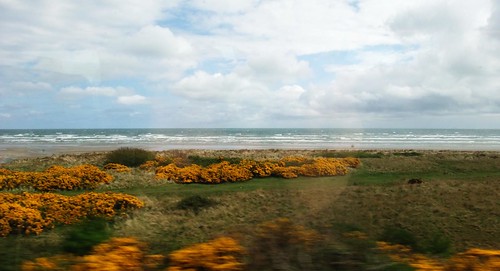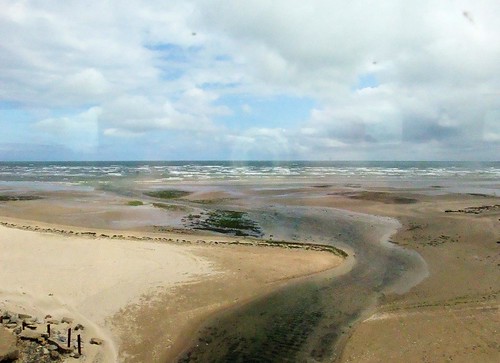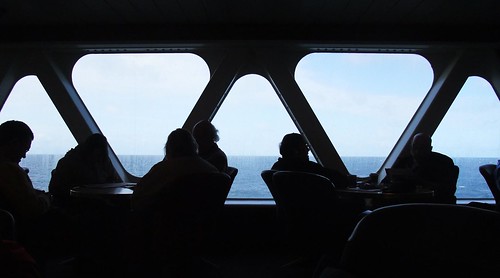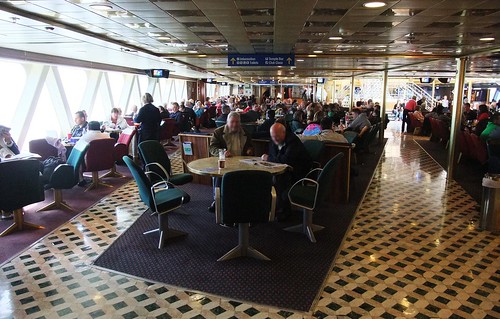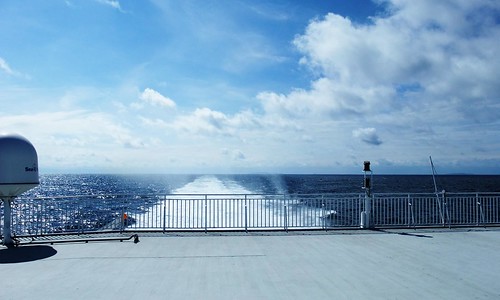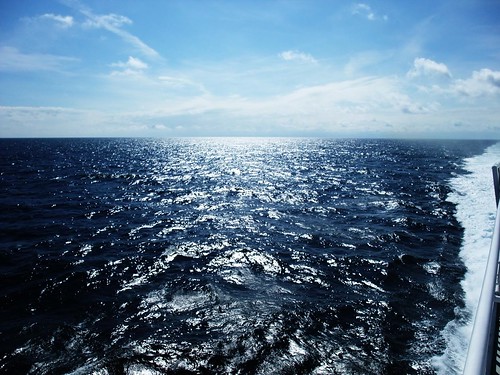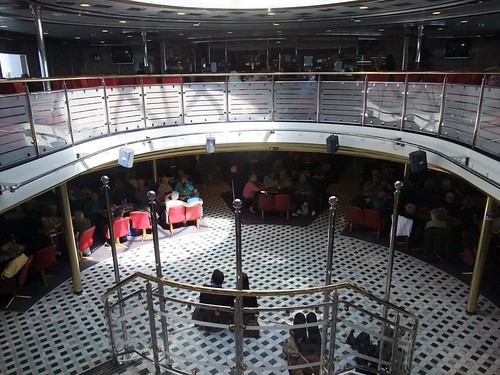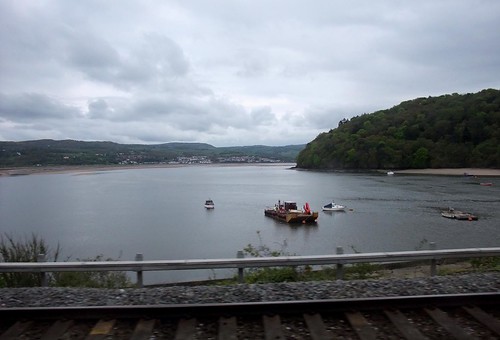Plane versus train and ferry for London to Belfast
Last weekend my wife and I went to Belfast for one of our best friend’s 30th birthday parties. We travelled from London to Belfast by EasyJet and from Belfast to London by train and ferry. We did look into getting the train & ferry for the outbound journey but unfortunately it takes too long: the journey takes about 13 hours door to door. But we finished work at 11pm on the Friday and we had to be in Belfast for 2pm on Saturday. Flying was the only way to get to Belfast in time. To be honest, we had planned to return by plane too but the ash cloud looked set to disrupt our flight so we got a refund and booked a train and ferry home!

Our return journey

The view from our plane over Northern Ireland
The single plane journey from London to Belfast cost £60 per passenger. The train & ferry cost £42 per passenger for the entire journey (it’s a single price no matter if you book on the day or in advance). The plane was in the air for about 1 hour. The train & ferry took a bit over 12 hours from station to station.

Looking out over the Irish countryside
So, how do you get from Belfast to London without flying? There are several ways. The way we did it was:
- train from Belfast to Dublin
- 15 minute bus ride to Dublin Ferry Port
- ferry to Holyhead
- train to Chester
- train to London
And how do they compare in terms of CO2 emissions? (updated with ferry CO~2~emission figures from WikiPedia)

All the trains were diesel electric averaging about 75% occupancy, the plane was about 90% full. Sources: plane & train, ferry
The flight from London to Belfast emitted about 163kg CO2 per passenger. The train + ferry option from Belfast to London (750km total) emitted 73kg CO2 per passenger (less than half the emissions of the flight from London to Belfast), with the vast majority coming from the fast diesel ferry (travelling at about 60km/h). If the transport infrastructure changed, how would the CO2 change? Some permutations:
- If we had gotten diesel-electric trains across land (as is currently the default) but sailed across the Irish sea, propelled by wind instead of taking the ferry then the entire journey from Belfast to London would have emitted just 25kg CO2 per passenger
- If there was a tunnel running electric trains beneath the Irish Sea, the total Belfast to London emissions would have been 28 kg CO2 per passenger (electric trains ~ 0.035kWh/p/km at 100% occupancy. UK grid = 0.544kgCO2/kWh. So electric trains = 19 gCO2/p/km)
- If all the trains were electric but we still got a diesel ferry: 60kg CO2 per passenger for the entire journey
- If the entire journey could be accomplished on electric trains: 14kg CO2 per passenger for Belfast to London.
All in all, this is just another reason to stop talking about it and actually learn to sail!
How did the journeys compare in terms of comfort and easy? Well, the outbound flight was easy to book (not least because my wife did it!) and was pretty painless. Hanging around in Belfast International airport for 6 hours only to be eventually be told the flight had been cancelled was less fun. (Many thanks to my parents for researching the ash cloud late on a Monday night and calling us with the details!) Booking the train & ferry initially looked like it would’ve been very easy because it’s possible to buy a single ticket which covers the entire journey (which is excellent news). But, unfortunately, there aren’t any FastTicket printing machines in Belfast so we couldn’t book our tickets the evening before travelling for collection in the morning, instead we had to buy our tickets at one Belfast station and then travel to another Belfast station to get the train. But the office opened at 9am and the default train from Belfast was due to leave at 8am so I had to spend midnight to 1am figuring out an alternative route which left Belfast at 10:30am so we had time to buy our tickets. The various websites I used to research travel information often had poor usability and some were just plain broken. Once we had booked our tickets, the train and ferry was actually a lovely way to travel; the countryside is gorgeous and our fellow passengers were very friendly. The food on the ferry was fine and the gold, green & red colour scheme was, um, memorable. The fact that Belfast Central station was playing Jeremy Kyle on the public plasmas screens was mildly surreal.
In a few week’s time, we’re going to Spain via train. I’ll blog about that soon. I expect the trip from London to Spain via train to be far greener than London to Spain via plane because the entire journey is done on trains and doesn’t involve any ferries (yay for the channel tunnel!)
Here are some photos from the trip:
Ireland:
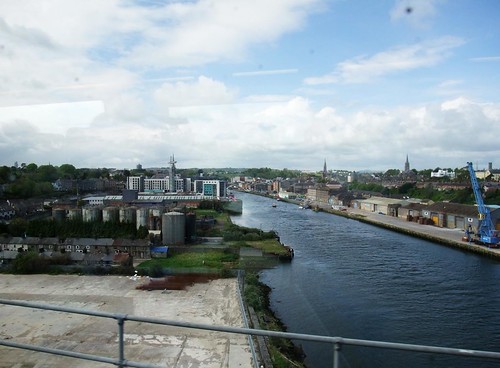
The ferry:
Wales:
A quick health warning about emissions calculations: it is logically impossible to obtain a near-perfect statistic when calculating the carbon emissions attributable to an action without defining a very tight scope (do you include the energy embedded in the trains themselves? What about the tracks? Do you include the CO2 emissions produced by drilling and pumping the gas which powers many UK power stations, or just the emissions coming out the flu? Didn’t the train occupancy vary? What about NOx emissions, water usage etc etc) The figures I’ve used are pretty rough and ready. But the aim here isn’t to calculate the carbon footprint to multiple decimal places, the aim is to help answer the question “which is less damaging to the environment: train or plane”? To that end, we only need rough figures so we can get a feel for which option has the largest CO2 emissions associated with it.
Update: It’s also worth noting that the total climate forcings attributable to aviation are believed to be 2-4 times greater than the aircraft’s CO2 emissions alone, largely because a bi-product of burning fossil fuels, nitric oxide, is converted more efficiently into tropospheric ozone (a potent greenhouse gas) when injected into the upper atmosphere by cruising aircraft than NO~x~ emissions at the surface (there’sa good summary on WikiPedia). However, there is a fair amount of uncertainty in the “2-4 times” figure and it’s also possible that the London to Belfast flight didn’t get to a high enough altitude for the NO~x~ -> Ozone effect to be significant. But it’s likely that the total radiative forcings attributable to flying from London to Belfast are at least 2-3 times larger (and possibly 6 times larger) than the land & sea alternative route. Hat-tip to Fergus in the comments below.
Update2: Finding authoritative numbers for the grammes of CO2 emitted per passenger per km for each mode of transport is pretty tricky. I’ve used one set of numbers in my calculations. Here are some other numbers(!):
- From the Booking Confirmation print-out that came with our tickets
(produced by National Rail, I think): All these numbers are grammes
of CO2 per passenger per km:
- Trains = 57
- Aeroplane = 187
- Bus/Coach = 69
- Diesel car = 99
- Petrol car = 103
- Motorcycle = 117
- Ferry emissions range MASSIVELY. Some estimates are below 100gCO2/p/km, some estimates are as high as 800gCO2/p/km.
- AMEE:
- Ferry = 115.2
- Train = 57.7
- Diesel trains
- Electric trains
